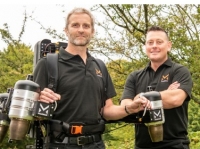The
jetpack is the brainchild of Hollywood animatronics expert Matt Denton and
Royal Navy Commander Antony Quinn and uses a unique Vertical Take-off and
Landing (VTOL) system designed to be operated hands-free, allowing people to
make safer flights, and precision landings on structures that are difficult to
access.
The
Maverick Jetpack can be
reconfigured as a heavy-lift drone capable of being operated remotely and
carrying ten times the payload of current similarly sized systems on the market
-- easily enough to lift a casualty like a stricken climber to safety.
Other
use cases include search & rescue, leisure, disaster relief, security and
policing. The company estimates the potential market for security, defence and
rescue uses alone is worth in excess of £700M. with the global lift market
worth approximately £525 BN a year
Helicopters
are currently used to carry out much of this work, but Maverick's Jetpack is
far smaller, uses sustainable fuel, and can slash costs.
The
jetpack is unusually light because Maverick exploited advanced manufacturing
techniques like 3D printing and materials including aluminium, titanium and
carbon fibre. It will travel at between 10mph and 30mph depending on the task.
The
operator can switch on an in-built autopilot so they can multi-task while in
flight if necessary. Early work on the control system software was funded by a £97,000
grant from Innovate UK, secured by Maverick's grant partner Catax . The team has since received additional
funding, including grants and business mentorship from the University of
Southampton Science Park and the company is about to start seeking further
investment to take the jetpack to market.
Co-founder
Matt Denton is also Maverick's CTO, well regarded for his work on animatronics
and control systems, having worked on numerous Star Wars movies that saw him
develop the BB-8 droid from 2015's Star Wars: The Force Awakens. He also worked
on Jurassic World and Harry Potter movies, The Prisoner of Azkaban and The
Goblet of Fire.
Co-founder
and CEO of Maverick Aviation, Antony Quinn commented.
"The jetpack uses the same sort of jet
engines that you see on a passenger plane, only ours are the size of a rugby
ball. What
is unique about what we're doing is the computer-controlled autopilot system
that makes flying effortless and easy to control with precision. That's how we
have changed jetpacks from exciting to useful.
"It's
so intuitive to fly that the cost of training is going to be low, so you're
going to have all sorts of professionals suddenly able to work in the most
inaccessible environments safely and quickly.
"I
realised that the growing onshore and offshore wind industry really needed a
solution like this. Their engineers climb up ladders inside these structures
for hours each day and, in an emergency situation, it's almost impossible to
get down quickly. Drones can be useful for inspections, but in many
circumstances you need to get an engineer up there.
"Before,
people would have used a £30m helicopter to perform some simple tasks, we can
offer a more tailored solution at a fraction of the cost."






